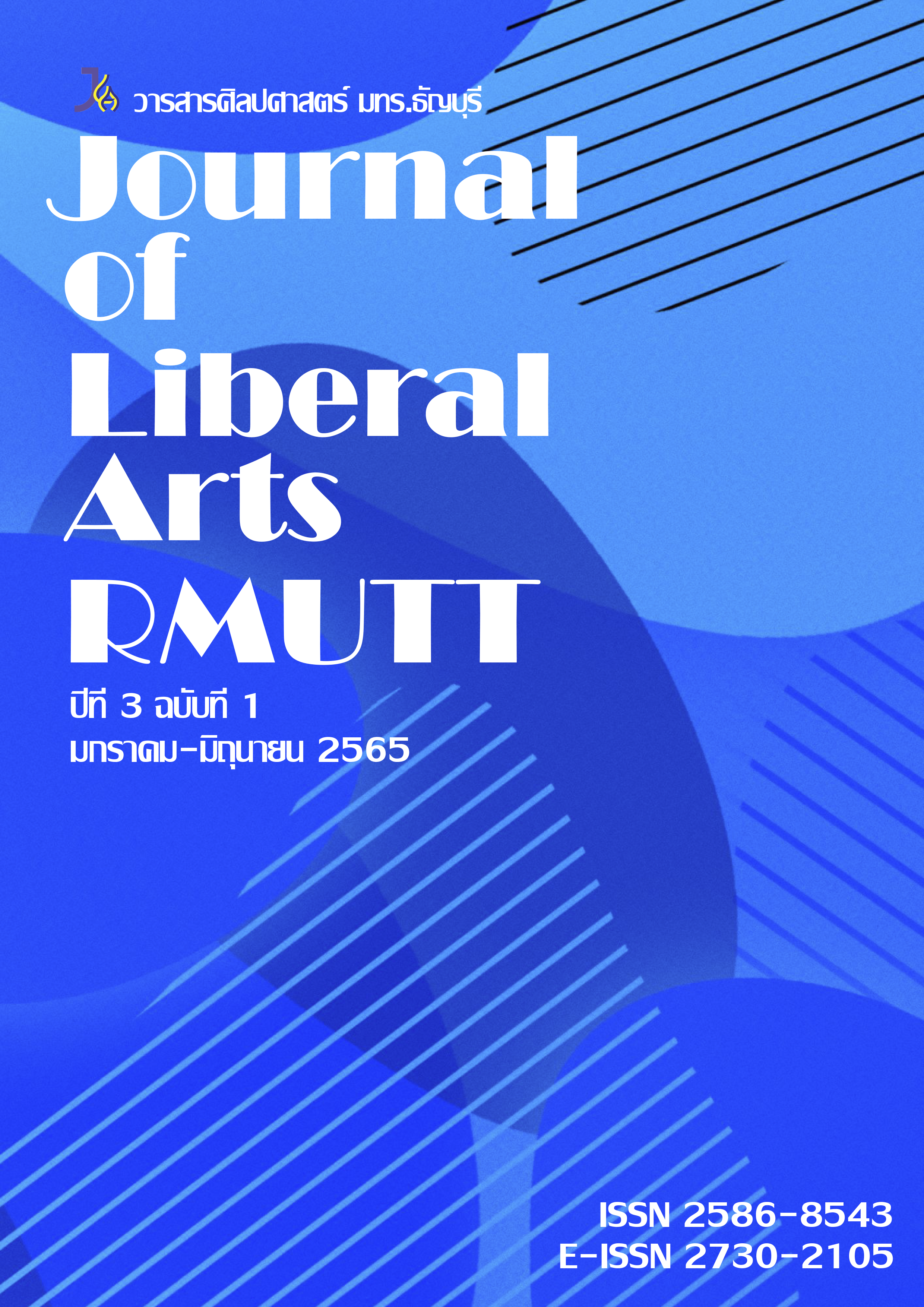Food Security among Students during the COVID-19 Pandemic
Abstract
Food insecurity among students takes place and continues to grow during the COVID-19 pandemic. There is an emerging body of work on the effect of the pandemic on education outcomes but there has been less concentrate on food security outcomes. In this article, we explore research trends on food security among students; contexts influencing student food security during the pandemic; recommendations on food security research issues among students in Thailand during the pandemic. The results reveal that, first of all, the outbreak of COVID-19 influences on student food security. Research on student food security during the epidemic focused on some issues such as (1) the situation of food insecurity among students (2) student food consumption patterns, and (3) dietary choices as well as adjustments of households and students in food consumption. (4) government policies. Student contexts affects how they encounter with their food security, especially the disruption of educational institutions as well as the income and economic status of households during the outbreak. Such contexts have a significant effect on students' access to food and are associated with socio-economic differences. Second, pointing out interesting research issues on food security among students which can apply those issues to do research during the COVID-19 outbreak in Thailand. Those research issues include rates of food insecurity and food insecurity experiences, capital, and urbanization. Food security is an interdisciplinary concept with relevance to economic, cultural, and social considerations. The sociological theory is one of the tools that can be used to understand food security among students during the epidemic.
References
กรมกิจการเด็กและเยาวชน และ องค์การยูนิเซฟประเทศไทย. (2563). แนวปฏิบัติการจัดการรายกรณีเพื่อคุ้มครองเด็กในสถานการณ์การแพร่ระบาดของโควิด-19. สืบค้น 22 กุมภาพันธ์ 2565, จากhttps://www.unicef.org/thailand/media/6301/file/Guideline%20for%20child%20protection%20case%20management%20during%20COVID-19.pdf
กสศ. (2563). กสศ. จับมือภาคเอกชน เปิดตัวแคมเปญ ‘มื้อนี้พี่เลี้ยง‘ บรรเทาภาวะขาดสารอาหารของนร.ยากจนพิเศษหลังโควิด-19. สืบค้น 9 กุมภาพันธ์ 2565, จาก https://www.eef.or.th/11-09-20/
เชษฐา พวงหัตถ์. (2556). การพัฒนาที่เหลื่อมล้ำ-ใครตกเป็นเหยื่อ?: ข้อพิจารณาจากมุมมองทางสังคมวิทยาระดับโลก. วารสารเศรษฐศาสตร์การเมือง, 1(1), 99-147.
ศุจิรัตน์ สิทธิโรจน์ และ ชญามาส วิชัยดิษฐ. (2563). ผลกระทบของโควิด-19 ต่อความมั่นคงทางอาหาร และการแก้ปัญหาด้วยเทคโนโลยี.วารสารสํานักงานนโยบายและยุทธศาสตร์การค้า, 11(113), 4-7.
Adams, E. L., Smith, D., Caccavale, L. J., & Bean, M. K. (2021). Parents Are Stressed! Patterns of Parent Stress Across COVID-19. Front. Psychiatry, 12(626456).
Borkowski, A., Ortiz-Correa, J. S., Bundy, D. A. P., Burbano, C., Hayashi, C., Lloyd-Evans, E., Neitzel, J., and Reuge, N. (2021). COVID-19: Missing More Than a Classroom. The Impact of School Closures on Children’s Nutrition. Innocenti Working Paper 2021-01. Florence: UNICEF Office of Research – Innocenti.
Bourdieu, P. (1986). The Forms of Capital. In J. Richardson (Ed.), Handbook of Theory and Research for the Sociology of Education. New York: Greenwood Press, pp. 241-258.
Bundy, D., de Silva, N., Horton, S., Jamison, D., Patton, G. (2018). Re-imagining School Feeding: A High-Return Investment in Human Capital and Local Economies. Disease Control Priorities 3, Volume 8. Washington, DC: World Bank.
Cady, C. L. (2014). Food Insecurity as a Student Issue. Journal of College and Character, 15(4), 265-272.
Chan, C., Deave, T., & Greenhalgh, T. (2010). Childhood Obesity in Transition Zones: An Analysis Using Structuration Theory. Sociology of Health & Illness, 32(5), 711–729.
DeBate, R., Himmelgreen, D., Gupton, J., & Heuer, J. N. (2021). Food Insecurity, Well-being, and Academic Success among College Students: Implications for Post COVID-19 Pandemic Programming. Ecology of Food and Nutrition, 60(5), 564–579.
Di Renzo, L., Gualtieri, P., Pivari, F., Soldati, L., Attinà, A., Cinelli, G., Leggeri, C., Caparello, G., Barrea, L., Scerbo, F., Esposito, E., & De Lorenzo, A. (2020). Eating Habits and Lifestyle Changes during COVID-19 Lockdown: An Italian Survey. Journal of Translational Medicine, 18(229), 1-15.
Éliás, A., & Jambor, A. (2021). Food Security and COVID-19: A Systematic Review of the First-Year Experience. Sustainability, 13(9), 1-18.
Institute of Medicine (US). (2011). Hunger and Obesity: Understanding a Food Insecurity Paradigm: Workshop Summary. Washington (DC): National Academies Press (US).
Jabbari, J., Chun, Y., Nandan, P., McDermott, L., Frank, T., Moreland-Russell, S., Ferris, D., & Roll, S. (2021). How Did School Meal Access Change during the COVID-19 Pandemic? A Two-Step Floating Catchment Area Analysis of a Large Metropolitan Area. International Journal of Environmental Research and Public Health, 18(21), 11350.
Kamphuis, C. B., Jansen, T., Mackenbach, J. P., & van Lenthe, F. J. (2015). Bourdieu's Cultural Capital in Relation to Food Choices: A Systematic Review of Cultural Capital Indicators and an Empirical Proof of Concept. PloS one, 10(8), 1-19.
Leddy, A. M., Whittle, H. J., Shieh, J., Ramirez, C., Ofotokun, I., & Weiser, S. D. (2020). Exploring the Role of Social Capital in Managing Food Insecurity among Older Women in the United States.
Social Science & Medicine, 265, 113492.
Mayurasakorn, K., Pinsawas, B.,Mongkolsucharitkul, P., Sranacharoenpong, K., & Damapong, S. (2020). School Closure, COVID-19 and Lunch Programme: Unprecedented Undernutrition Crisis in Low-middle Income Countries. Journal of Paediatrics and Child Health, 56, 1013-1017.
Mokariyamchi, A., Alizadeh-Sani, M., Khezerolou, A., Firouzsalari, N.Z., Akbari, Z., & Ehsani, A. (2018). Resolving the Food Security Problem with an Interdisciplinary Approach. Nutrition Fasting Health, 6(3), 132-138.
Morales, D. X., Morales, S. A., & Beltran, T. F. (2021). Food Insecurity in Households with Children Amid the COVID-19 Pandemic: Evidence from the Household Pulse Survey. Social Currents, 8(4), 314–325.
Napoli, M.D., Muro, P.D., & Mazziotta, M. (2010). Towards a Food Insecurity Multidimensional Index (FIMI). Roma: Roma Tre, Universita Degli Studi. Retrieved on February 24, 2022, from http://www.fao.org/fileadmin/templates/ERP/uni/FIMI.pdf.
Powell, P.K., Lawlera, S., Durhamb, J., & Cullerton, K. (2021). The Food Choices of US University Students during COVID-19. Appetite, 161(2021), 1-8.
Punch, S., McIntosh, I., & Emond, R. (2010). Children's Food Practices in Families and Institutions. Children's Geographies, 8(3), 227-232.
Rodrigues, E. C., Mendonça, R. de D., Camargo, P. P., Menezes, M. C. de, Carvalho, N. C. de, & Meireles, A. L. (2022). Home Food Insecurity during the Suspension of Classes in Brazilian Public Schools due to the COVID-19 Pandemic. Nutrition, 93(2022), 1-6.
Scanlan, S. J. (2003). Food Security and Comparative Sociology. International Journal of Sociology, 33(3), 88–111.
Scanlan, S. J. (2009). New Direction and Discovery on the Hunger Front: Toward a Sociology of Food Security/Insecurity. Humanity & Society, 33(4), 292–316.
Schwabish, J., Joo, N., Waxman, E., Spievack, N. (2020). Strategies and Challenges in Feeding Out-of-School Students. DC: Urban Institute.
Strickhouser, S. (2016). Food Insecurity, Social Inequality, and Social Policy. (Doctoral Dissertation). The University of Central Florida, Orlando, FL.
St. Pierre, C., Guan, W., Merrill, J., & Sacheck, J. M. (2022). Urban Youth Perspectives on Food Insecurity during the COVID-19 Pandemic: Evidence from the COACHES Study. Nutrients, 14(3): 455, 1-9.
Szabo, S. (2016). Urbanisation and Food Insecurity Risks: Assessing the Role of Human Development. Oxford Development Studies, 44(1), 28-48.
Tan, C., & Liu, D. (2018). What is the Influence of Cultural Capital on Student Reading Achievement in Confucian as Compared to non-Confucian Heritage Societies?. A Journal of Comparative and International Education, 48(6), 896-914.
The Hope Center for College, Community, and Justice. (2021). #RealCollege 2021: Basic Needs Insecurity During the Ongoing Pandemic. Philadelphia, PA.
UNICEF, FAO, & WFP. (2020). Mitigating the Effects of the COVID-19 Pandemic on Food and Nutrition of Schoolchildren. Retrieved on February 24, 2022, from https://www.unicef.org/media/68291/file/Mitigating-the-Effects-of-the-COVID-19-Pandemic-on-Food-and-Nutrition-of-school-children.pdf
United Nations. (2021). The Sustainable Development Goals Report. New York: United Nations Publications. Retrieved on February 24, 2022, from https://unstats.un.org/sdgs/report/2021/The-Sustainable-Development-Goals-Report-2021.pdf
Wang, Y.-W., Cruz, T. E., & Bush, L. (2019). UMD Food Access & Student Well-being Study. College Park, MD: University of Maryland Counseling Center Research Unit.
Willis, D. E., & Fitzpatrick, K. M. (2019). Food Insecurity and Social Capital Among Middle School Students. Youth & Society, 51(8), 1127–1144.
World Food Programme. (2006). Distinguishing between Chronic and Transitory Food Insecurity in Emergency Needs Assessments. Rome: World Food Programme.
Yokoro, M., Wakimoto, K., Otaki, N., & Fukuo, K. (2021). Increased Prevalence of Breakfast Skipping in
Female College Students in COVID-19. Asia Pacific Journal of Public Health, 33(4), 438–440.
Downloads
Published
How to Cite
Issue
Section
License
Copyright (c) 2022 Journal of Liberal Arts RMUTT

This work is licensed under a Creative Commons Attribution-NonCommercial-NoDerivatives 4.0 International License.









